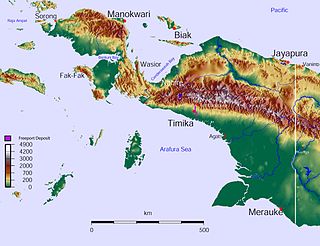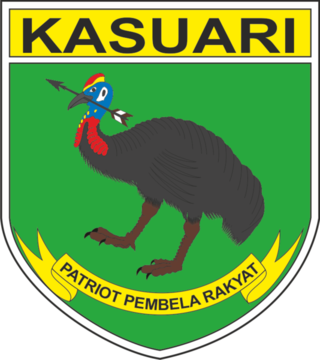
The Free Papua Movement or Free Papua Organization is a name given to an independence movement based on Western New Guinea, seeking liberation of the territory from colonial Indonesian administration. The territory is currently divided into six Indonesian provinces of Central Papua, Highland Papua, Papua, South Papua, Southwest Papua, and West Papua, also formerly known as Papua, Irian Jaya and West Irian.

The Act of Free Choice was a controversial plebiscite held between 14 July and 2 August 1969 in which 1,025 people selected by the Indonesian military in Western New Guinea voted unanimously in favor of Indonesian control.

Dortheys Hiyo Eluay International Airport, also known as Sentani International Airport is an airport serving Jayapura, the capital of Papua province, Indonesia, on the island of New Guinea. It is located in the Sentani District, approximately 40 km from downtown Jayapura; the name 'Sentani' is taken from Lake Sentani nearby. It is the easternmost airport in Indonesia, the main hub, and the largest airport on the island of New Guinea. On 14 October 2019, the management of the airport was taken over by PT Angkasa Pura I (Persero).

Wamena, also known as the District of Wamena, is a large town in the Western New Guinea region of Indonesia. It also serves as the seat of Jayawijaya Regency. It is the largest town in the province of Highland Papua, located in the Baliem Valley and had a population of 64,967 in the 2020 Census; the official estimate in mid 2023 was 66,080. Wamena is the urban centre of a rural area housing Highland Papua's highest concentration of population, with over 300,000 people inhabiting the Baliem Valley and surrounding areas. These people belong to several related ethnic groups, the most prominent of which are the Dani, Lani, and Yali.

The Papua conflict is an ongoing conflict in Western New Guinea (Papua) between Indonesia and the Free Papua Movement. Subsequent to the withdrawal of the Dutch administration from the Netherlands New Guinea in 1962 and implementation of Indonesian administration in 1963, the Free Papua Movement has conducted a low-intensity guerrilla war against Indonesia through the targeting of its military, police, as well as civilian populations.
Jacob Rumbiak is a West Papuan academic and political leader who has been in self-imposed exile in Australia after escaping from detention as a political prisoner for ten years in Indonesian gaols. Rumbiak is the Foreign Affairs representative of the Federated Republic of West Papua declared at the conclusion of the Third Papuan People's Congress on 19 October 2011. Rumbiak's advice from within West Papua to not attend the Congress for security reasons was vindicated in the crack-down which led to six deaths, hundreds of arrests and the sentencing of five of the principal figures to three years gaol each for treason.

The Papuan Volunteer Corps was a corps consisting entirely of Papuans, formed on February 21, 1961. It was established to contribute to the defense of Dutch New Guinea against the infiltration of the Indonesian Army. The establishment of the corps by the Dutch Cabinet was approved in December 1959, and the corps was to serve as a semi-military police.
The History of Western New Guinea refers to the history of the Indonesian western half of the island of New Guinea and other smaller islands to its west. This region was previously named Irian Jaya. The eastern half of the island is Papua New Guinea.
Mathias Wenda was the Commander in Chief of the West Papua Revolutionary Army (WPRA). He has been active in West Papua independence movement since his early age in his village, Pyramid, West Papua. In 1977, became the leader of the fight against the Indonesian occupation. He fled to Papua New Guinea upon the surrender of most of the villagers in 1980.

Operation Trikora was a combined Soviet-Indonesian military operation which aimed to seize and annex the Dutch overseas territory of Netherlands New Guinea in 1961 and 1962. After negotiations, the Netherlands signed the New York Agreement with Indonesia on 15 August 1962, relinquishing control of Western New Guinea to the United Nations.

Komando Daerah Militer XVII/Cenderawasih or Kodam XVII/Cenderawasih, is a military area command of the Indonesian Army, as the 17th Kodam, which is responsible for the defense of the provinces of Papua, South Papua, Central Papua and Highland Papua.

Major TNI Marthen Indey (1912–1986) was a colonial police officer in New Guinea, Dutch East Indies who later became nationalist fighter in the Indonesian National Revolution and a supporter of Papua becoming part of Indonesia. He was declared a National Hero of Indonesia in 1993 along with two other people of Papuan descent, Frans Kaisiepo and Silas Papare.
The Mapenduma hostage crisis began on 8 January 1996 after the Free Papua Movement took 26 members of a World Wildlife Fund research mission captive at Mapenduma, Jayawijaya in Irian Jaya, Indonesia. The hostages were subsequently moved to Geselama. The International Committee of the Red Cross acted as an intermediary between the OPM and the Indonesian authorities. Fifteen hostages, all of Indonesian nationality, were released relatively quickly, but eleven remained in OPM hands. After lengthy negotiations the ICRC secured an agreement for the release of the remaining hostages on 8 May. However, the OPM leader, Kelly Kwalik, backed out of the agreement on the day of the intended release. The ICRC removed itself from the negotiations and stated that the Indonesian Army was no longer bound by an agreement not to engage in combat with the hostage takers.

The West New Guinea dispute (1950–1962), also known as the West Irian dispute, was a diplomatic and political conflict between the Netherlands and Indonesia over the territory of Dutch New Guinea. While the Netherlands had ceded sovereignty over most of the Dutch East Indies to Indonesia on 27 December 1949 following an independence struggle, it retained control over its colony on the western half of New Guinea. The Indonesian government claimed this territory as well, on the basis that it had belonged to the Dutch East Indies and that the new Republic of Indonesia was the legitimate successor to the former Dutch colony.
The Nduga massacre was a shooting of construction workers that occurred on 1 December 2018, in Nduga Regency, Papua, Indonesia. The shooting is considered to be part of the Papuan conflict. The West Papua National Liberation Army (TPNPB) acknowledged responsibility and the Indonesian government labeled the attack a massacre.
The Arfai incident was a skirmish between Indonesian Army soldiers and Free Papua Movement fighters backed by local sympathizers on 28 July 1965, where the fighters launched a raid against an Indonesian barracks in an attempt to capture firearms.

Komando Daerah Militer XVIII/Kasuari, is the Defense Regional Command in Southwest Papua, and West Papua Province, which was created in 2016 with the division of parts of Kodam XVII/Cenderawasih which is located in Jayapura, Papua Province.
Seth Jafeth Rumkorem was a West Papuan military officer and independence activist. He chose to defect from the Indonesian Army to the Free Papua Movement (OPM) after witnessing electoral fraud and human rights abuses conducted by the former. He quickly became the leader of the movement's armed wing and was among the signatories of the proclamation of the Republic of West Papua. He went into exile to Greece, after an attempt to secure weapons for OPM went wrong. He eventually relocated to the Netherlands, where he continued his activism until his death in 2010.

The West Papua National Liberation Army, officially referred to in Indonesia as the Armed Criminal Group, and after 2021, Separatist Terrorist Group, is a Western New Guinean insurgent group in Indonesia. It is the armed wing of the Free Papua Movement.
The following is the broad timeline for major events in the Papua conflict.










